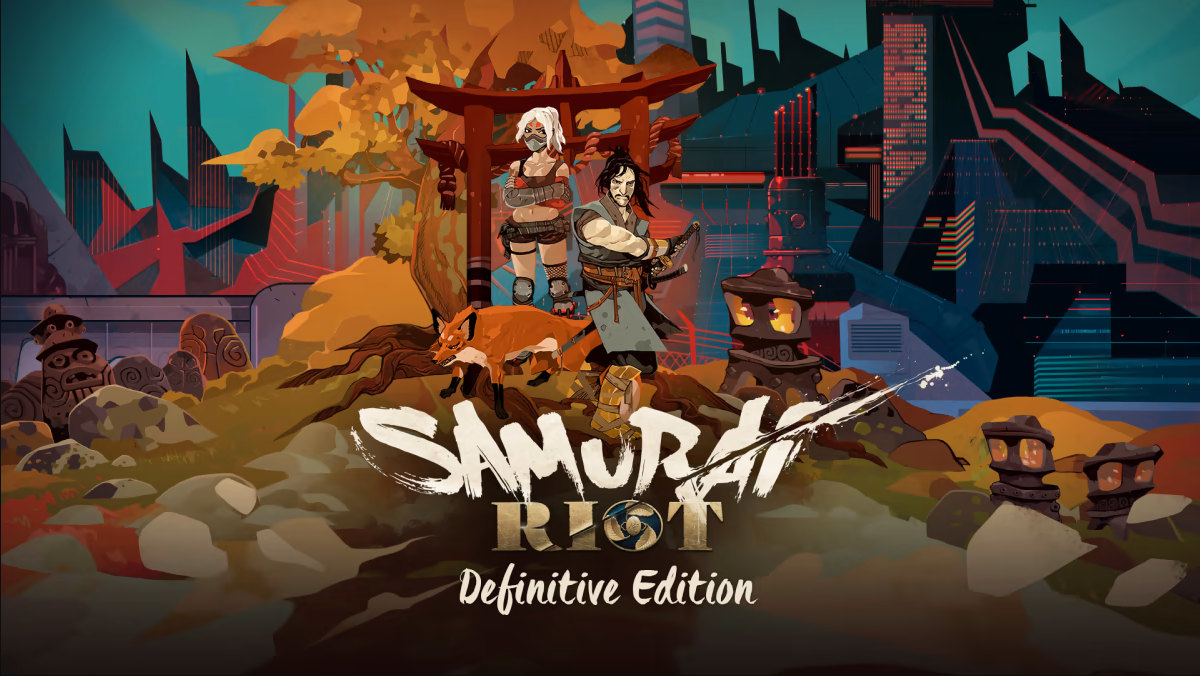Samurai Riot: Definitive Edition
What Is Honor? Is It Personal Or Loyalty?
Originally released in 2017 by indie French studio Wako Factory, Samurai Riot was an interesting spin on the 2D beat-em-up genre. Rather than brawl in the streets or take over New York with a band of half-shelled turtles, players fought it out across various traditional Japanese environments. The premise was simple enough. A samurai and a kunoichi serve a master and they are tasked to fight off a rebellion. Upon arriving, things aren't exactly what they seem at first glance. Shortly after, it's left to the player's devices on how to tackle the course of the playthrough. In 2022, a "Definitive Edition" was released for the first time on the Nintendo Switch as well as a replacement for the original title on Steam.
According to the linear notes, Samurai Riot: Definitive Edition adds quality of life changes to the gameplay, making it easier to combo and move around. The dialogue was also altered for a better understanding of the plot. By default, there's a bonus "fighting school" variant included named Belladonna, which according to the Steam database, was originally DLC for the original game. Before we begin, I'd like to thank the folks at Houndpicked Games for giving us the opportunity to review this game. They've worked on the publishing for the Switch version which was the platform we've played on. I've personally worked with these guys for years now, so their efforts toward gaming are always greatly appreciated.

Embrace Modernity, Reject Tradition?
What makes Samurai Riot stands apart from other games of the same genre is that it contains elements of a visual novel. Not so much in its cutscenes, which play at the beginning and end of each level, but from the player's choices. First, starting with the characters, there are two to choose from. The samurai, Tsurumaru, is a by-the-book swordsman for hire who is glued to his beliefs of "might makes right." The kunoichi, Sukane, is younger and free-spirited, going wherever the wind takes her and standing up for those who can't fight on their own. Their ideologies clash at times but they never come to blows in single-player mode. In co-op, however, players can literally fight each other should they come to a disagreement and the surviving player will have their decision fulfilled.
Going back to the original predicament, after stopping the small uprising, the common folk are planning a revolution to upstage the corrupt master. The very same master that the player has sworn allegiance to. Here a decision must be made as the player can actually join the uprising and betray their master as early as the first level. They can also remain loyal and kill the leader, thwarting the rebellion (for now). Samurai Riot is a game where there is no "right or wrong" answer, as both have specific consequences. This also means that no two playthroughs are the same.

Freedom Of Choice, Freedom Of Consequence
In my playthrough, I played as Sukane who had her own dialogue separate from Tsurumaru. Depending on who the player selects, they begin with a dire predicament, detailing that their fates can be changed if decisions were made. In Sukane's vision, they are overwhelmed by demons. Tsurumu's vision shows him committing seppuku as a ghostly image of a woman watches on. Regardless of who is selected, the choices to make are similar. I decided to go with the revolution and see how my betrayal would go. At this point, I'd like to mention that moving forward there will be light spoilers.
Eventually, the duo is introduced to Makoto, the leader of the rebellion, and it's clear that she's a spitting image of the former master they recently betrayed. Both are power-hungry leaders who obviously have their better interests in mind, but it's not clear at first. This is revealed when the duo accidentally nukes an entire village per Makoto's orders and it is here that I'm both intrigued yet confused about the time period. Samurai Riot is heavily inspired by the likes of Samurai Jack in that there's a blend of modern and traditional aesthetics.

Samurai Riot's Purpose Isn't For Historical Accuracy
If you side with the rebellion, the next levels involve going through a modern industrial city, climbing across scaffolding and warehouses. Later levels are far more familiar to the time period that Samurai Riot reflects, but there is greater evidence to prove that the game's time period may be in the distant future. Tsurumu's weapons involve grenades and some of the enemies are equipped with guns and dynamite. While these certainly existed in feudal Japan, these are modern variants shown instead.
The music even reflects this, with a blend of traditional Japanese music and hip-hop not unlike something heard in Samurai Champloo. The game's soundtrack, along with the hand-drawn art, is some of the most beautiful I've heard in a beat-em-up. Even with the intensity of the action, the music always brought me back to a leveled head. Readers can check out the soundtrack here on the dev's official Bandcamp.

The Game Of Chess Is A Sword Fight, You Must Think Before You Move
The freedom of choice, the hip-hop traditional music, the surprisingly in-depth narrative, and the art style are all great points for Samurai Riot so far. However, the most important key is its gameplay and fortunately, it's solid without falling into "unfair territory." I've not played the original Samurai Riot so I cannot compare how difficult or easy the original was. What I can say is that there is a moderate challenge that progresses throughout a playthrough. There are seven levels, each with stronger variants of the enemies the players will fight. As the order of the levels changes depending on decisions made, these changes may reflect sooner or later than others.
Each enemy type has an attack pattern that players must identify to ensure they don't take unnecessary damage. The first enemy type, Glasses with spears, are slow and cannot block. They can, however, overwhelm the player and poke from a safe distance. The muscular women with the tonfa can block and counter-attack with a "Shoryuken"-style attack.

Kappa. (Not the Twitch emote, but, the actual Kappa)
There are big guys with shields that require players to be mindful of their openings. Then there are gunslingers strapped with dynamite that will shoot you for insane damage and take half of your health bar away while blowing themselves up. Finally, to round out the human enemies, there are ninjas that are agile and can throw you while there are skilled samurai that have the fortitude of bosses. Each level has a unique boss with its own gimmick and mechanic. I realized later that Sukane's kitsune is incredibly useful as I was able to use the fox to kite the enemy from the air and break their guard.
The lack of enemy variation is mitigated with the enemy types being color-coded in their rank of power and skill. The black ninjas are far greater in strength than the grey ones, which gives players insight into how to handle the threats. Destroying objects will reveal health, chi, and bonus life power-ups. Some may even be concealed tanuki that will drop point items. At the end of each fight, there's a ranking that range from "gold" to "wood." The higher the ranking, the higher the score, and the higher the points which can be used to purchase new "fighting styles."

Is Honor Personal Gratification? Or Is It The Sake Of Others Around You?
By the end of my playthrough, the only regret I felt was my decision in the final choice. Even the ending stayed true to each character's personality as Sukane did not agree with the "status quo" remaining. Tsurumu, again being a sword-for-hire, remained within the confines of the situation. Regardless of the eight endings received, the player gets a final score and a chance to play a different route. There are no new characters or extra "survival modes" to unlock.
Samurai Riot: Definitive Edition's replay value lies on the various outcomes that players can come across. Maybe siding with your master would ensure they would rule for life. Or it'd be best to think of the people and have them live without a sociopathic ruler in a time of peace? Regardless, the concept of maintaining the past and embracing the future is neatly touched upon without drowning the player in exposition. Should the player remain patient, Samurai Riot is a fun beat-em-up that improves on several rough spots from its original release.

Samurai Riot: Definitive Edition is available on PC and Switch.

